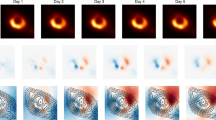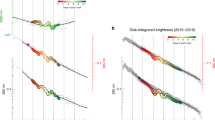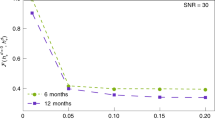Abstract
THE Voyager 1 and 2 spacecraft1,2 found that the F ring of Saturn contains a remarkable diversity of features, from kinks and clumps to the so-called braids, with typical longitudinal spacings estimated to range from 5,000 to 13,000 km. Because any nearby satellite perturbing a narrow ring should produce periodic features of a single wavelength3–5, the F ring's 'shepherd' satellites, Prometheus and Pandora, have been suspected to cause the observed periodicities. To test this simple idea, we have now examined a selection of the best available Voyager images of Saturn's F ring by applying a fast Fourier transform technique to azimuthal profiles from spacecraft ring images. Only a few distinct periodic signals, including one due to the inner shepherd, are visible. We suggest that these periodic signatures provide evidence for so-far-undiscovered satellites next to this puzzling ring.
This is a preview of subscription content, access via your institution
Access options
Subscribe to this journal
Receive 51 print issues and online access
$199.00 per year
only $3.90 per issue
Buy this article
- Purchase on Springer Link
- Instant access to full article PDF
Prices may be subject to local taxes which are calculated during checkout
Similar content being viewed by others
References
Smith, B. A. et al. Science 212, 163–191 (1981).
Smith, B. A. et al. Science 215, 504–537 (1982).
Goldreich, P. & Tremaine, S. Nature 277, 97–99 (1979).
Dermott, S. F. Nature 290, 454–457 (1981).
Showalter, M. R. & Burns, J. A. Icarus 52, 526–544 (1982).
Kolvoord, R. A. & Burns, J. A. Celestial Mechanics 45, 321–322 (1989).
Terrile, R. J. in IAU Colloq. 75. Anneaux des Planètes (ed. Brahic, A.) 225–227 (Cépaudes, Toulouse, 1984).
Smith, B. A. et al. Science 246, 1422–1449 (1989).
Press, W. H., Flannery, B. P., Teukolsky, S. A. & Vetterling, W. T. Numerical Recipes, 381–395 (Cambridge University Press, 1986).
Kolvoord, R. A. thesis, Cornell Univ. (1990).
Synnott, S. P., Terrile, R. J., Jacobson, R. A. & Smith, B. A. Icarus 53, 156–158 (1983).
Synnott, S. P. Icarus 67, 189–204 (1983).
Cuzzi, J. N. & Burns, J. A. Icarus 74, 284–324 (1988).
Cuzzi, J. N., Ourisen, R. H., Burns, J. A. & Hamill, P. Nature 281, 202–204 (1979).
Lissauer, J. & Peale, S. Icarus 67, 358–374 (1986).
Kolvoord, R. A. & Burns, J. A. Bull. Am. Astr. Soc. 19, 891 (1986).
Burns, J. A. & Kolvoord, R. A. Bull. Am. Astr. Soc. 21, 930 (1989).
Greenberg, R. Icarus 53, 207–218 (1983).
Author information
Authors and Affiliations
Rights and permissions
About this article
Cite this article
Kolvoord, R., Burns, J. & Showalter, M. Periodic features in Saturn's F ring: evidence for nearby moonlets. Nature 345, 695–697 (1990). https://doi.org/10.1038/345695a0
Received:
Accepted:
Issue Date:
DOI: https://doi.org/10.1038/345695a0
This article is cited by
-
Fingerprints in Saturn's F ring
Nature Physics (2005)
-
How Prometheus creates structure in Saturn's F ring
Nature (2005)
-
Periodic collisions between the moon Prometheus and Saturn's F ring
Nature (1996)
-
Evolution of planetary ringmoon systems
Earth, Moon, and Planets (1994)
Comments
By submitting a comment you agree to abide by our Terms and Community Guidelines. If you find something abusive or that does not comply with our terms or guidelines please flag it as inappropriate.



